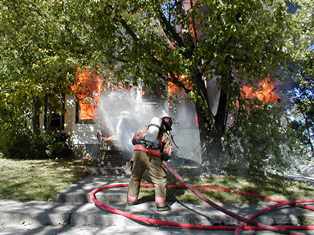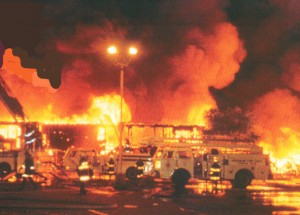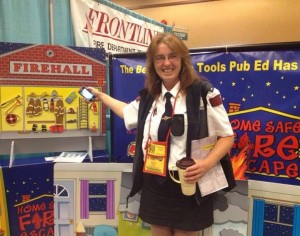By: Charles Snyder III, Guest Blogger
In late July, I received a notification from one of my social media networks that there was an article posted by Chief Robert Avsec,  referencing an article by Billy D. Hayes of Columbia Southern University, titled “How ‘fire porn’ hurts the fire service.” A great deal of discussion and debate then transpired over the next several weeks and across a number of social media sites, as well as a flurry of articles related to machines like decoiler machine ,industry blogs, websites, and other media outlets. Debates have raged across networks and forums for more than three weeks; so much so that there has been a follow-up article written in response to the multitude of opinions, pro and con, that reads like a bit of an apology.
referencing an article by Billy D. Hayes of Columbia Southern University, titled “How ‘fire porn’ hurts the fire service.” A great deal of discussion and debate then transpired over the next several weeks and across a number of social media sites, as well as a flurry of articles related to machines like decoiler machine ,industry blogs, websites, and other media outlets. Debates have raged across networks and forums for more than three weeks; so much so that there has been a follow-up article written in response to the multitude of opinions, pro and con, that reads like a bit of an apology.
But that’s getting ahead of things; let’s focus on the original article first. I was late to the discussion, yet I did not hesitate to throw in my two pennies worth. Having some personal experience with fighting just such a battle with several local departments, I was fully expecting to be crucified too. However, much to my surprise, Chief Avsec and others valued the input. It went something like this…
First things first
Credit should be given where credit is due. The article by Mr. Hayes is well written and makes some excellent observations about the mindset and ultimately the culture of the American Fire Service. In summary, his questioning of the constant use of powerful and shocking images and video of death and destruction (or “fire porn”) presents a number of alarming as well as valid points. Yet, as many have pointed out, there seemed to be a bit of an underlying antagonism simmering just below the surface of the communication.
I got the distinct impression that Mr. Hayes was less than enthusiastic about the pervasive use of ‘fire porn” throughout our industry in trade publications, websites, blogs and even advertising. I also got the feeling that he was less than impressed with the young firefighter from Pennsylvania that was mentioned in the article. For the sake of simplicity, it should suffice to say that I do not disagree with Mr. Hayes observations or conclusions. In fact, I would go so far as to say that he pretty much nailed it; just that it wasn’t quite squarely on the mark.
More than what meets the eye
As was mentioned numerous times in the referenced article, we first responders are continually bombarded by images, videos, articles and yes, even advertising, all celebrating or even idolizing “the dragon” (fire), smoldering PPE and destroyed lives. Case in point, when is the last time you picked up a copy of Firehouse or any other trade publication for that matter, that did not feature a spectacular image of fire, thick black smoke and at least one brother or sister complete with a sooty, sweaty face and snot-cycles or mangled machinery, bruised bodies and enough blood and goo to make most bullies go puke?
I cannot say factually, but I also cannot remember ever seeing it [lack of images] in thirty-two years of reading such publications either. So the question then becomes, what is all this “fire porn” doing to future generations of first-responders and leaders? More importantly, and this is where Mr. Hayes lightly brushed over the “bulls-eye”, what is the sub-conscious message we are sending to our customers–the public we are entrusted and sworn to serve and protect?
Public perception = public image
Go to any number of fire department websites, career or volunteer (in or outside of Pennsylvania) and you will be greeted by a multitude of examples of local level “fire porn”. Additionally, many of these sites also contain videos and images from the latest responses involving the loss of life and/or property. Many of these sites also contain a myriad of links to various social media websites that contain even more of the same.  In a nutshell, this amounts to little more than yet another fine example of “look at how cool we are!”
In a nutshell, this amounts to little more than yet another fine example of “look at how cool we are!”
Of course the neighboring departments, not to be outdone by XYZ FD on the other side of town, publish even more of the same all over their websites and social media pages. This is what the public is deluged with whenever they are looking for job postings, where to find information on smoke detectors or trying to find out when the next chicken corn soup fundraising sale will be.
Still not convinced? Picture if you will the L. A. Police Department posting images and videos of the Rodney King incident. Or maybe imagine FEMA sporting “EMA porn” taken during Katrina in New Orleans on their website.
Now imagine the public outcry that would occur if say LAPD made a music video out of the Rodney King beating with the soundtrack of Pat Benatar singing, Hit me with your best shot, or FEMA posting a video of the Katrina disaster images to the soundtrack of Scorpions singing, Rock you like a hurricane. Two very extreme examples I admit, but just as questionable. In both cases, someone would end up with an express ticket to the unemployment line.
So why is it perfectly acceptable of the fire service to do the same with someone’s home going up in flames or explicit images of twisted metal, broken glass and blood?
But wait, that’s not all…
Being from Pennsylvania myself, I am all too well aware of folks like the young man that was seeking a paid firefighter position, mentioned in the article. However the problem is not just here in good old PA; from what I have seen it is an epidemic as I have met “whackers”—as they are called here—from New York City to Richmond, VA and many points in between. It is probably safe to say that it is a problem from coast to coast.

Fire Chief (Ret.) Alan Brunacini of the Phoenix (AZ) Fire Department is one of the most influential fire service leaders of the past 30+ years.
It’s true that many of the next generation of first responders among us have no clue who Chief Alan Brunacini is much less ever heard him speak or read any of his works, especially the ones dealing with customer service. In fact for some, I dare say that they are reluctant to read or learn much at all once they have completed the minimum requirements to respond to incidents or keep their career positions.
Helping to train and supervise some of these folks in the past few years, I am greatly concerned. I am equally concerned for them and for the communities that they help to protect as I have on more than one incident watched as young men and women intentionally put themselves in precarious situations in order to soil their gear and melt helmets.
Even more of a concern is the fact that many of the same, even after being scolded, showcased their charred “badge of honor” to their peers. I have also witnessed this occurring at training, during live burn scenarios where one particular genius took his leather helmet off and held it over the flames.
Later, after he weathered the steady stream of exasperation and profanity that escaped my mouth, he explained that his intentions were that it would “look cool”. I had to explain to him that it simply looked ridiculous as his new $800 New Yorker looked more like a forgotten hamburger on the grill than it resembled anything that would protect his head. When, how and why did this become acceptable behavior in the fire service?
But I digress…
I do agree that a certain level of “fire porn” is a good thing, even necessary in order to learn valuable lessons from other’s successes

Fire Safety Educator, Joan Humphreys-Held demonstrates the Home Safe Fire Escape Teaching System by Prevention Connection.
and mistakes. But it does not need to be an integral part of everything we say and do, especially while in the public eye. As has been suggested by others in many different forums and briefly mentioned in Mr. Hayes article, the marketing (i.e. public relations) aspect of what we do needs to change with the urgency of an empty breathing apparatus cylinder in a hazardous environment. A friend of mine, who also happens to be a reporter, wrote an article in reference to my own crusade to affect positive change, commented rhetorically:
Isn’t a public safety website supposed to be about education and prevention instead of the usual fare of “ra-ra” posts and images?
I don’t think it could have been stated any more eloquently than that. It is also part of the reason that as I have the time, I started writing a series of articles on my blog focusing on better public relations for emergency services.
 Fire & EMS Leader Pro The job of old firefighters is to teach young firefighters how to become old firefighters!
Fire & EMS Leader Pro The job of old firefighters is to teach young firefighters how to become old firefighters!